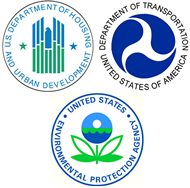Cincinnati, Ohio
Contact Information
Jon Grosshans
(grosshans.jon@epa.gov)
Community Planner
U.S. EPA Region 5
77 W. Jackson Blvd., SM-7J
Chicago, IL 60604
312-353-5617
Lick Run Watershed Strategic Integration Plan
EPA commissioned the Lick Run Watershed Strategic Integration Plan to outline coordinated actions, investments and decision-points that could be needed to implement a sustainable infrastructure program approach for combined sewer overflow control at the Metropolitan Sewer District of Greater Cincinnati (MSD). The plan will identify the specific public investments, actions, milestones and opportunities to implement a viable sustainable infrastructure.
Sustainable infrastructure approaches to combined sewer overflow mitigation have been demonstrated to provide multiple social, environmental and economic benefits when coordinated with other revitalization efforts and investments. These benefits range from regulatory compliance and beautification to potential job training, land banking, and brownfields revitalization.
You will need Adobe Reader to view some of the files on this page. See EPA's PDF page to learn more.
- Lick Run Watershed Strategic Integration Plan (PDF) (40pp, 4.1MB) - July 2011
- Appendices A-H (PDF) (65pp, 5.8MB)
- Appendix I: Technical Report (PDF) (58pp, 7.2MB) 2009
- Land Revitalization Fact Sheet (PDF) (2pp, 975K) - April 2011
Cincinnati Water Quality History
The project is one result of a legal agreement - known as a "consent decree" - between the EPA and MSD to deal with sewer overflows affecting the city and the Ohio River. MSD must capture, treat or remove 85 percent of the 14 billion gallons of annual overflows from the city's combined storm and sanitary sewers, and eliminate all overflows from sanitary-only sewers. It involves a $2 billion infrastructure investment that has the potential to become a revitalization driver for several Cincinnati neighborhoods. What's unique about this agreement is the opportunity to do green infrastructure projects, which are potentially an economical and ecological solution that allows the city to save money while providing more benefits to citizens. As such, Project Groundwork is "not just another sewer project."
Lick Run Watershed - Green Infrastructure and Land Revitalization
The Lick Run watershed lies within the Mill Creek Valley watershed and is a focus area for MSD's effort to use both grey and green infrastructure, rather than conventional underground tunnels. As one part of Project Groundwork, MSD must remove approximately 1.6 billion gallons of the annual combined sewer flows from the Lower Mill Creek watershed. Lick Run is a 2,700-acre area on the west side of the city - an area that includes the South Fairmount neighborhood and parts of several others. The Lick Run subwatershed includes MSD's largest combined sewer. Most of the volume from the watershed is natural drainage and stormwater runoff. The strategy is to move stormwater through a new above-ground channel rather than through the sewer. This concept creates a long, linear stormwater park that will benefit the South Fairmount neighborhood, an environmental justice area.
An initial sustainable infrastructure project concept for the Lick Run Watershed ![]() is on MSD's website.
is on MSD's website.
Lick Run Watershed - Green Infrastructure and Brownfields
The Brownfields program supports this project through targeted brownfields assessment work in the corridor, analyzing the brownfield parcels in the corridor that are targeted for MSD acquisition. A sweeping Phase I analysis was completed on all the parcels in the Lick Run corridor. Also, a brownfields grant has been awarded to the Cincinnati Port Authority. The port authority may do Phase II work in the corridor using some of these grant funds, examining potentially contaminated properties critical to the wet weather strategy implementation.
![[logo] US EPA](../gif/logo_epaseal.gif)
